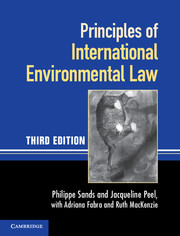Book contents
- Frontmatter
- Contents
- Foreword
- Preface and acknowledgments to the first edition
- Preface and acknowledgments to the second edition
- Preface and acknowledgments to the third edition
- Table of cases
- Table of treaties and other international instruments
- Abbreviations
- Part I The legal and institutional framework
- 1 The environment and international society: issues, concepts and definitions
- 2 History
- 3 Governance: states, international organisations and non-state actors
- 4 International law-making and regulation
- 5 Compliance: implementation, enforcement, dispute settlement
- Part II Principles and rules establishing standards
- Part III Techniques for implementing international principles and rules
- Part IV Linkage of international environmental law and other areas of international law
- Index
- References
4 - International law-making and regulation
from Part I - The legal and institutional framework
Published online by Cambridge University Press: 05 June 2012
- Frontmatter
- Contents
- Foreword
- Preface and acknowledgments to the first edition
- Preface and acknowledgments to the second edition
- Preface and acknowledgments to the third edition
- Table of cases
- Table of treaties and other international instruments
- Abbreviations
- Part I The legal and institutional framework
- 1 The environment and international society: issues, concepts and definitions
- 2 History
- 3 Governance: states, international organisations and non-state actors
- 4 International law-making and regulation
- 5 Compliance: implementation, enforcement, dispute settlement
- Part II Principles and rules establishing standards
- Part III Techniques for implementing international principles and rules
- Part IV Linkage of international environmental law and other areas of international law
- Index
- References
Summary
INTRODUCTION
This chapter identifies the sources of international legal obligation in the field of the environment, and the regulatory techniques used to give effect to these obligations. International law is traditionally stated to comprise ‘the body of rules which are legally binding on states in their intercourse with each other’. These rules derive their authority, in accordance with Article 38(1) of the Statute of the International Court of Justice (ICJ), from four sources: treaties, international custom, general principles of law, and subsidiary sources (decisions of courts and tribunals and the writings of jurists and groups of jurists). It is to these sources that international courts look in determining whether a particular legally binding principle or rule of international environmental law exists. The list of sources identified in Article 38(1) does not wholly reflect the sources of obligation, broadly understood, which have arisen in international environmental law. A list of sources of international environmental law is more properly reflected in the list proposed by the International Law Commission (ILC) in 1989, which included those identified in Article 38(1) as well as binding decisions of international organisations, and judgments of international courts or tribunals.
Beyond these sources of ‘hard law’, which establish legally binding obligations, there are also so-called rules of ‘soft law’, which are not binding per se but which in the field of international environmental law can play an important role; they point to the likely future direction of formally binding obligations, by informally establishing acceptable norms of behaviour, and by ‘codifying’ or possibly reflecting rules of customary law. It is also worth recalling that, although the rules of public international law primarily govern relations between states, it is now widely accepted that states are no longer the only subjects of international law, and that the rules of international law can, and do, impose obligations upon other members of the international community, in particular international organisations and, to a more limited extent, non-state actors, including individuals and corporations.
- Type
- Chapter
- Information
- Principles of International Environmental Law , pp. 94 - 134Publisher: Cambridge University PressPrint publication year: 2012



